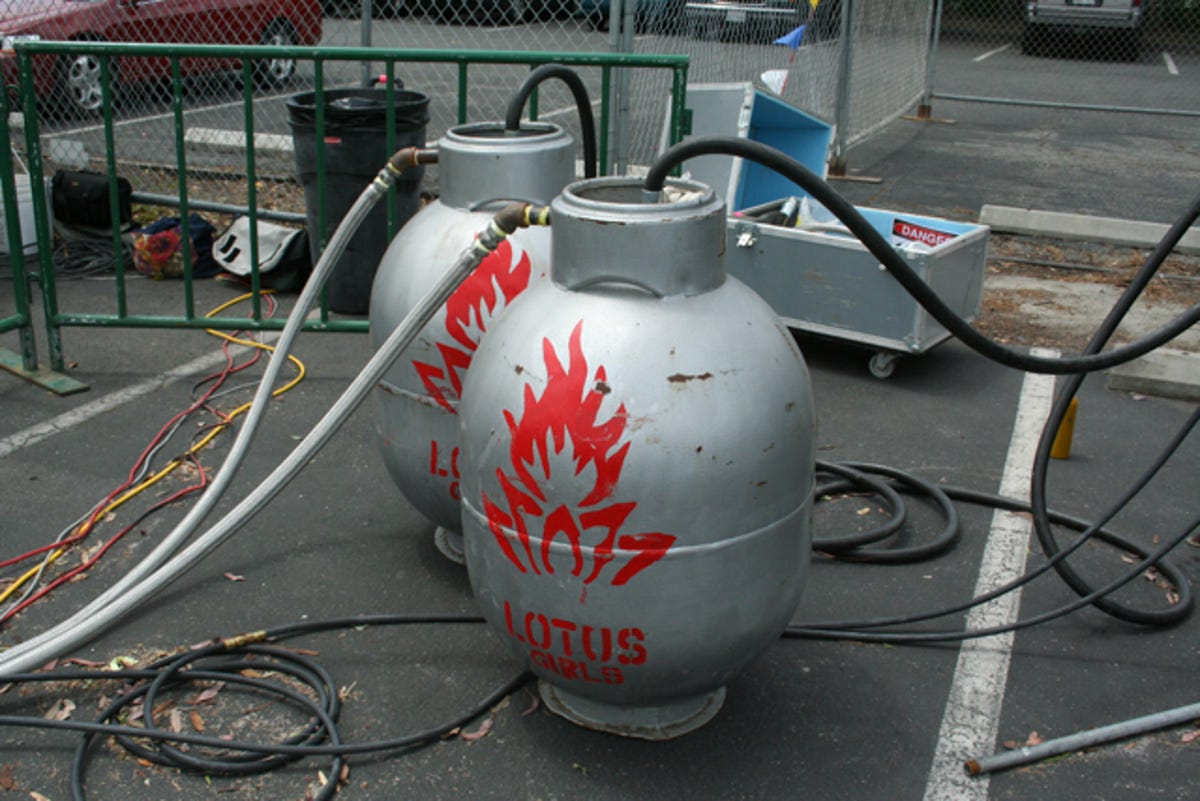Propane is used in many ways, from heating homes to helping cook the perfect meal on your grill. Like their uses, propane tanks come in many shapes and sizes. The most commonly known are the 20- and 15-pound tanks used for outdoor cooking and patio heaters.
While most of these smaller portable tanks get exchanged at local retailers for a new full tank, that isn’t always the case. Sometimes, you may have changed from a gas grill to a pellet model or charcoal grill and no longer need the tank. At which point, you must decide what to do with a cylinder containing a highly combustible substance.
Not to worry. Here are the options you have for safely and properly discarding your propane tank.
How to properly dispose of a propane tank

Here are two propane tanks being used by the Flaming Lotus Girls for the arts collective’s project, Soma, which uses both fire and LEDs for effect.
While the tank may no longer be of use to you, it’s most definitely not trash, at least not in the sense that you can simply put it on the curb with your other garbage. Not only will your trash service not pick it up, but it is also highly dangerous to leave it on the roadside.
An easy way to get that propane tank off your hands would be to check with friends to see who may have a use for it. You could sell it to them for less than buying a new tank, which can easily be over $60, trade it for something you want from them, or just be cool and give it to them. But if you’d prefer to go a different route or don’t know anyone who wants it, there are other options.
Find a propane tank exchange location

Propane exchange locations are widely available and can help you get a new propane tank or dispose of unwanted tanks.
The two most widely available exchange brands are Blue Rhino and Amerigas, and these exchange locations are found at many gas stations, grocery stores and other big box stores. Called exchange locations because, typically, when you use up all the propane in your grill tank, you’d trade your old tank for a new full one at a discount over buying brand new.
If you no longer need the tank, you simply write “recycle” on the side of the tank and drop it off. This is also the solution for a damaged tank.
Aside from no longer wanting the tank or dropping it off due to damage, propane tanks must be recertified 12 years after the manufacture date. This date is found stamped into the handle of the tank. Then, recertification has to happen every five years after that. So if your tanks falls into that criteria, write “recycle” on it and drop it off at an exchange location. If you have a local propane distributor, you can also do this through it.
Go local

Propane tanks need recertified 12 years after the manufacture date and every five years after that.
If you can’t find an exchange location near you or would prefer to go a more official route, you can contact your local hazardous waste disposal office or public works department. Both of these entities can help you dispose of your tank or help you find where it can be done. These options are generally free of charge or cost a nominal fee.
These options are also the point of contact for disposing of the smaller 1-pound tanks that many portable and camping grills use but also where you would go, in addition to contacting a local propane distributor, for discarding larger tanks over 20 pounds.
Safe storage and transportation

Milk crates make great holders for propane tanks to keep them upright and easier to carry for transportation.
Remember, these metal tanks contain a highly flammable liquid — propane, yes, in liquid form. Even when your grill will no longer ignite from the “empty” propane tank, there can still be traces of the fuel inside, which can be dangerous.
It’s important to always store your propane tanks standing upright. A helpful way to ensure a tank doesn’t accidentally get tipped over is to keep it in another, more stable container, like a milk crate. Propane tanks should also never be stored in direct sunlight and keep in temperatures below 120 degrees Fahrenheit and over minus 40 degrees Fahrenheit.
This is also a great way to help transport your propane tank for disposal or exchange. If you have to put the tank inside your vehicle, make sure the valve is fully closed, crack the windows and even put the seat belt on it to help keep it from moving while you drive.
Propane is a commonly used fuel source, so it’s important to know how to properly use, store, transport and dispose of it when the time comes. This is both safety for you and those around you.



















+ There are no comments
Add yours